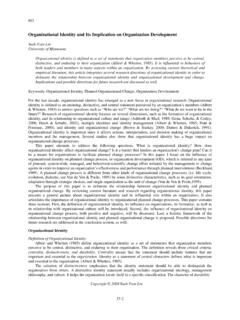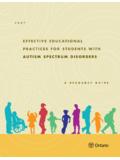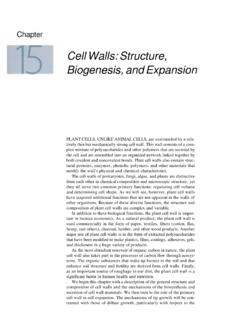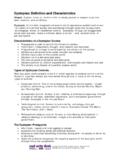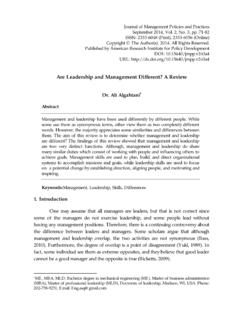Transcription of FEDERAL RULES OF EVIDENCE: 801-03, 901
1 172 FEDERAL RULES OF evidence : 801-03, 901 Rule 801. Definitions The following definitions apply under this article: (a) Statement. A "statement" is (1) an oral or written assertion or (2) nonverbal conduct of a person, if it is intended by the person as an assertion. (b) Declarant. A "declarant" is a person who makes a statement. (c) Hearsay. "Hearsay" is a statement, other than one made by the declarant while testifying at the trial or hearing, offered in evidence to prove the truth of the matter asserted. (d) Statements which are not hearsay. A statement is not hearsay if-- (1) Prior statement by witness. The declarant testifies at the trial or hearing and is subject to cross-examination concerning the statement, and the statement is (A) inconsistent with the declarant's testimony, and was given under oath subject to the penalty of perjury at a trial, hearing, or other proceeding, or in a deposition, or (B) consistent with the declarant's testimony and is offered to rebut an express or implied charge against the declarant of recent fabrication or improper influence or motive, or (C) one of identification of a person made after perceiving the person; or (2) Admission by party-opponent.
2 The statement is offered against a party and is (A) the party's own statement, in either an individual or a representative capacity or (B) a statement of which the party has manifested an adoption or belief in its truth, or (C) a statement by a person authorized by the party to make a statement concerning the subject, or (D) a statement by the party's agent or servant concerning a matter within the scope of the agency or employment, made during the existence of the relationship, or (E) a statement by a coconspirator of a party during the course and in furtherance of the conspiracy. The contents of the statement shall be considered but are not alone sufficient to establish the declarant's authority under subdivision (C), the agency or employment relationship and scope thereof under subdivision (D), or the existence of the conspiracy and the participation therein of the declarant and the party against whom the statement is offered under subdivision (E).
3 Rule 802. Hearsay Rule Hearsay is not admissible except as provided by these RULES or by other RULES prescribed by the Supreme Court pursuant to statutory authority or by Act of Congress. Rule 803. Hearsay Exceptions; Availability of Declarant Immaterial The following are not excluded by the hearsay rule, even though the declarant is available as a witness: (1) Present sense impression. A statement describing or explaining an event or condition made while the declarant was perceiving the event or condition, or immediately thereafter. (2) Excited utterance. A statement relating to a startling event or condition made while the declarant was under the stress of excitement caused by the event or condition. (3) Then existing mental, emotional, or physical condition. A statement of the declarant's then existing state of mind, emotion, sensation, or physical condition (such as intent, plan, motive, design, mental feeling, pain, and bodily health), but not including a statement of memory or belief to prove the fact remembered or believed unless it relates to the execution, revocation, identification, or terms of declarant's will.
4 (4) Statements for purposes of medical diagnosis or treatment. Statements made for purposes of medical diagnosis or treatment and describing medical history, or past or present symptoms, pain, or sensations, or the inception or general character of the cause or external source thereof insofar as reasonably pertinent to diagnosis or treatment. (5) Recorded recollection. A memorandum or record concerning a matter about which a witness once had knowledge but now has insufficient recollection to enable the witness to testify fully and accurately, shown to have been made or adopted by the witness when the matter was fresh in the witness' memory and to reflect that knowledge correctly. If admitted, the memorandum or record may be read into evidence but may not itself be received as an exhibit unless offered by an adverse party. (6) Records of Regularly Conducted memorandum, report, record, or data compilation, in any form, of acts, events, conditions, opinions, or diagnoses, made at or near the time by, or from information transmitted by, a person with knowledge, if kept in the course of a regularly conducted business activity, and if it was the regular practice of that business activity to make the memorandum, report, record or data compilation, all as shown by the testimony of the custodian or other qualified witness, or by certification that complies with Rule 173 902(11), Rule 902(12), or a statute permitting certification, unless the source of information or the method or circumstances of preparation indicate lack of trustworthiness.
5 The term "business" as used in this paragraph includes business, institution, association, profession, occupation, and calling of every kind, whether or not conducted for profit. (7) Absence of entry in records kept in accordance with the provisions of paragraph (6). evidence that a matter is not included in the memoranda reports, records, or data compilations, in any form, kept in accordance with the provisions of paragraph (6), to prove the nonoccurrence or nonexistence of the matter, if the matter was of a kind of which a memorandum, report, record, or data compilation was regularly made and preserved, unless the sources of information or other circumstances indicate lack of trustworthiness. (8) Public records and reports. Records, reports, statements, or data compilations, in any form, of public offices or agencies, setting forth (A) the activities of the office or agency, or (B) matters observed pursuant to duty imposed by law as to which matters there was a duty to report, excluding, however, in criminal cases matters observed by police officers and other law enforcement personnel, or (C) in civil actions and proceedings and against the Government in criminal cases, factual findings resulting from an investigation made pursuant to authority granted by law, unless the sources of information or other circumstances indicate lack of trustworthiness.
6 (9) Records of vital statistics. Records or data compilations, in any form, of births, fetal deaths, deaths, or marriages, if the report thereof was made to a public office pursuant to requirements of law. (10) Absence of public record or entry. To prove the absence of a record, report, statement, or data compilation, in any form, or the nonoccurrence or nonexistence of a matter of which a record, report, statement, or data compilation, in any form, was regularly made and preserved by a public office or agency, evidence in the form of a certification in accordance with rule 902, or testimony, that diligent search failed to disclose the record, report, statement, or data compilation, or entry. (11) Records of religious organizations. Statements of births, marriages, divorces, deaths, legitimacy, ancestry, relationship by blood or marriage, or other similar facts of personal or family history, contained in a regularly kept record of a religious organization.
7 (12) Marriage, baptismal, and similar certificates. Statements of fact contained in a certificate that the maker performed a marriage or other ceremony or administered a sacrament, made by a clergyman, public official, or other person authorized by the RULES or practices of a religious organization or by law to perform the act certified, and purporting to have been issued at the time of the act or within a reasonable time thereafter. (13) Family records. Statements of fact concerning personal or family history contained in family Bibles, genealogies, charts, engravings on rings, inscriptions on family portraits, engravings on urns, crypts, or tombstones, or the like. (14) Records of documents affecting an interest in property. The record of a document purporting to establish or affect an interest in property, as proof of the content of the original recorded document and its execution and delivery by each person by whom it purports to have been executed, if the record is a record of a public office and an applicable statute authorizes the recording of documents of that kind in that office.
8 (15) Statements in documents affecting an interest in property. A statement contained in a document purporting to establish or affect an interest in property if the matter stated was relevant to the purpose of the document, unless dealings with the property since the document was made have been inconsistent with the truth of the statement or the purport of the document. (16) Statements in ancient documents. Statements in a document in existence twenty years or more the authenticity of which is established. (17) Market reports, commercial publications. Market quotations, tabulations, lists, directories, or other published compilations, generally used and relied upon by the public or by persons in particular occupations. (18) Learned treatises. To the extent called to the attention of an expert witness upon cross-examination or relied upon by the expert witness in direct examination, statements contained in published treatises, periodicals, or pamphlets on a subject of history, medicine, or other science or art, established as a reliable authority by the testimony or admission of the witness or by other expert testimony or by judicial notice.
9 If admitted, the statements may be read into evidence but may not be received as exhibits. (19) Reputation concerning personal or family history. Reputation among members of a person's family by blood, adoption, or marriage, or among a person's associates, or in the community, concerning a person's birth, adoption, marriage, divorce, death, legitimacy, relationship by blood, adoption, or marriage, ancestry, or other similar fact of personal or family history. 174 (20) Reputation concerning boundaries or general history. Reputation in a community, arising before the controversy, as to boundaries of or customs affecting lands in the community, and reputation as to events of general history important to the community or State or nation in which located. (21) Reputation as to character. Reputation of a person's character among associates or in the community. (22) Judgment of previous conviction.
10 evidence of a final judgment, entered after a trial or upon a plea of guilty (but not upon a plea of nolo contendere), adjudging a person guilty of a crime punishable by death or imprisonment in excess of one year, to prove any fact essential to sustain the judgment, but not including, when offered by the Government in a criminal prosecution for purposes other than impeachment, judgments against persons other than the accused. The pendency of an appeal may be shown but does not affect admissibility. (23) Judgment as to personal, family, or general history, or boundaries. Judgments as proof of matters of personal, family or general history, or boundaries, essential to the judgment, if the same would be provable by evidence of reputation. (24) [Transferred to Rule 807] Rule 901. Requirement of Authentication or Identification (a) General provision. The requirement of authentication or identification as a condition precedent to admissibility is satisfied by evidence sufficient to support a finding that the matter in question is what its proponent claims.










